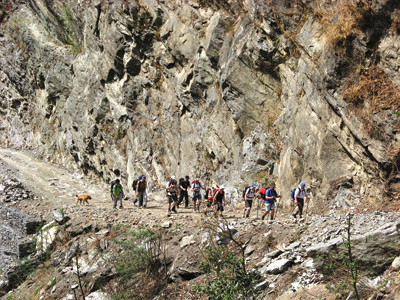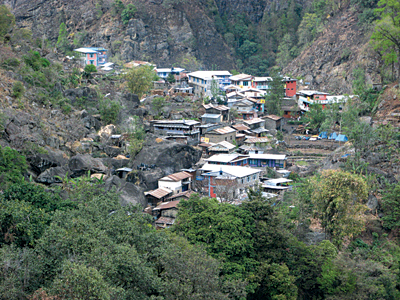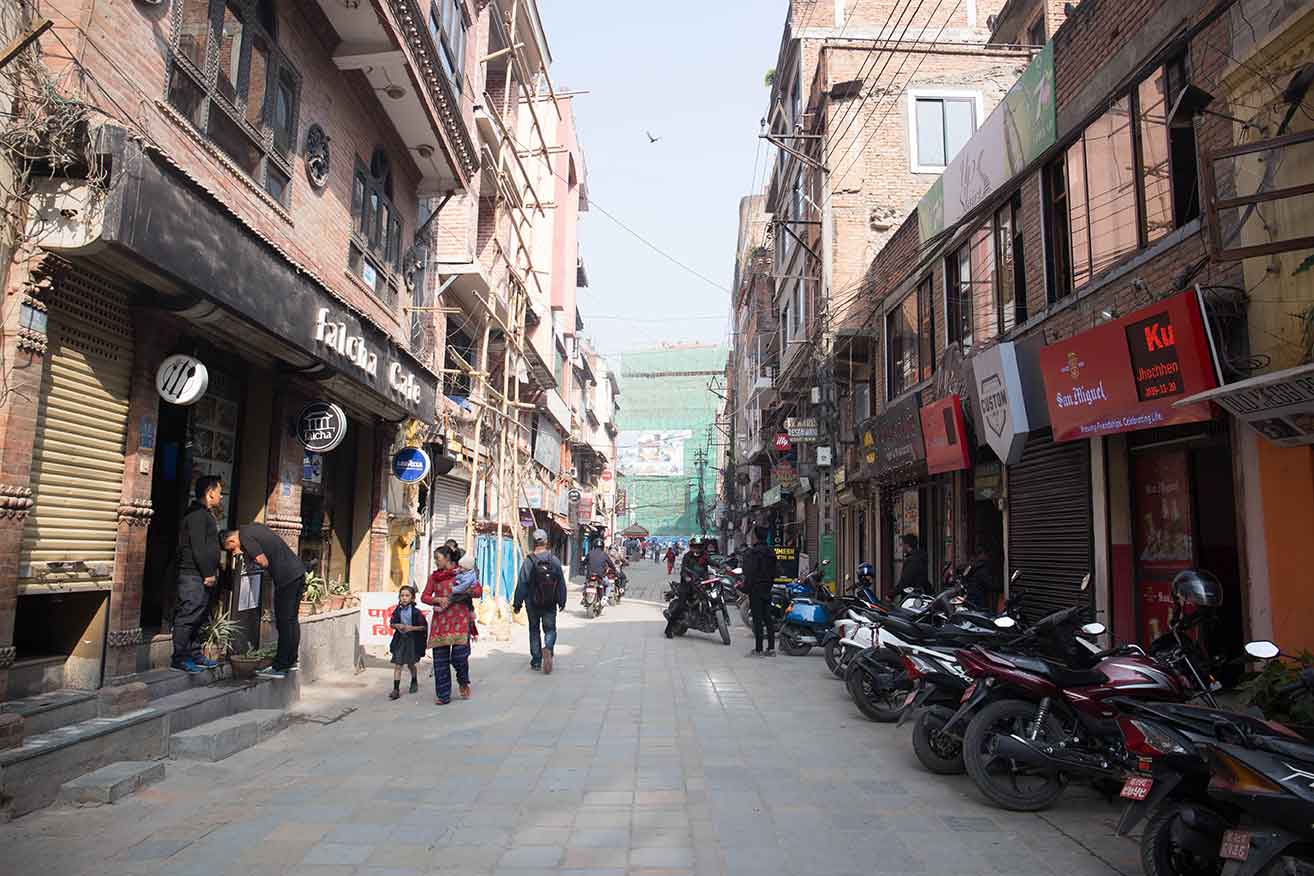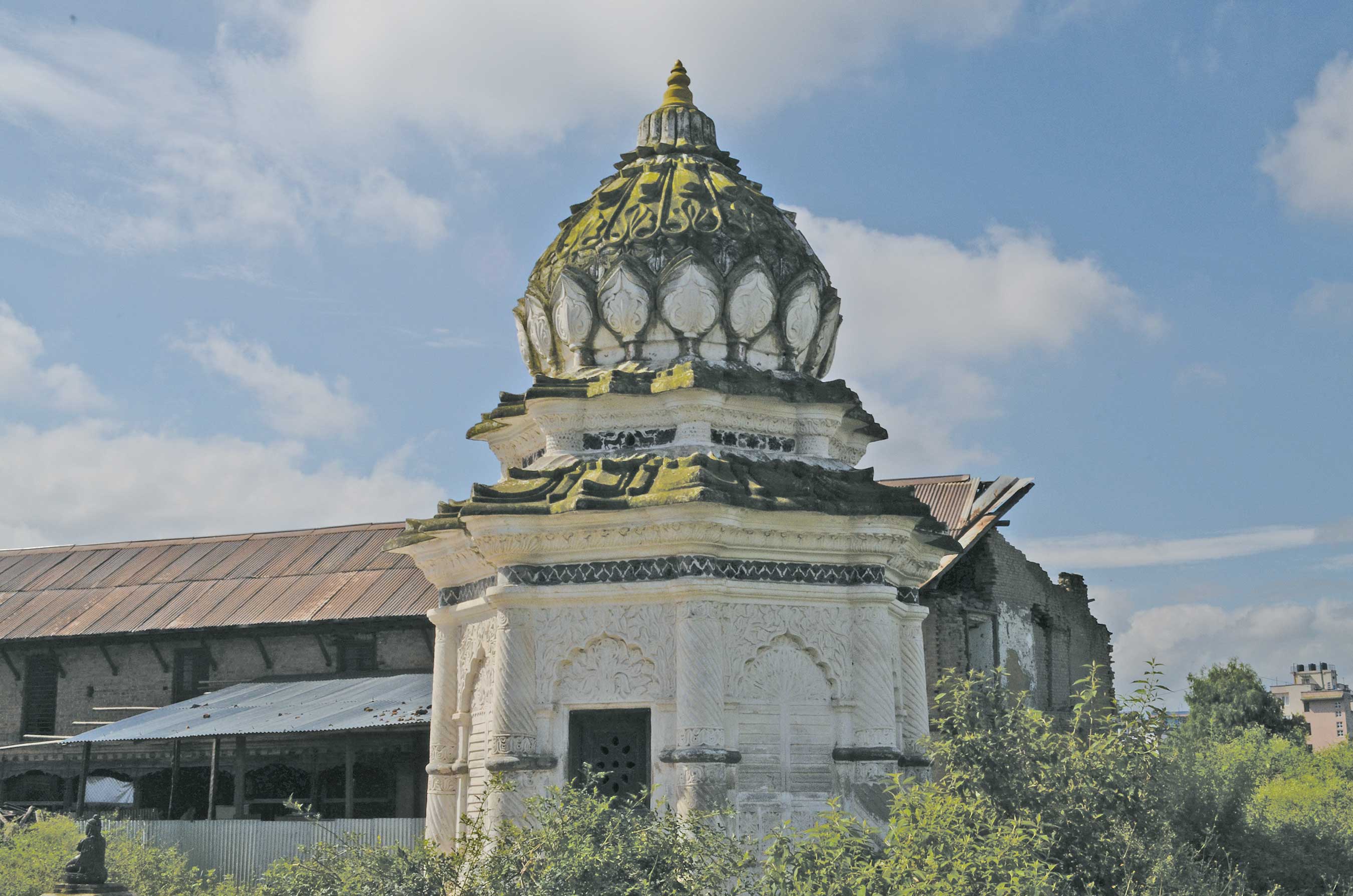When you hike the popular ‘Annapurna Circuit’ or the ‘Manaslu Circuit’ you pass through the wild Marsyangdi river gorge. While most trekking stories describe the whole long circuit tour, the focus here is on the gorge, its geographical and cultural features, and its visual allure.
 Pure Entertainment
Pure Entertainment
The Marsyangdi gorge is a wild place, pure geological and hydrological entertainment. Steep cliffs rise straight up from ‘the raging river’ (the local translation of ‘marsyangdi’). Over its approximately 20 kilometer length (12.5 miles) between Dharapani and Syangé the river drops about 860 meters, or 43 meters per kilometer (c. 224 feet/mile). In the monsoon, this glacial torrent runs chocolate brown. In winter it’s a silty, silky turquoise. In every season it is punctuated by plunging torrents.
The Round Manaslu trek goes up the Buddhi Gandaki river in eastern Gorkha District, then crosses Larkya La west into Manang and down past Bimthang (an old seasonal salt trading depot) and Tiljé village, south along the Dudh Khola (river) valley to Thonjé (Thoche) and Dharapani. At Dharapani, the Dudh joins the Marsyangdi, which plunges immediately into the gorge, all the way south to Syangé in Lamjung District. By comparison, when trekking the Annapurna Circuit the gorge comes first; it’s where you start. Either way, the trail through the gorge gives you a glimpse of a rough middle Himalayan landscape.
The gorge is a trekkers delight, a photographer’s dream, a kayaker’s thrill, and a canyoneer’s challenge. It is literally crammed down between Manaslu Himal (the world’s 8th highest peak) at the east and the high spires of Lamjung Himal (an extension of the Annapurnas) at the west. The peaks, however, are largely out of sight from the trail. On either side of the gorge, Gurung villages cling to the high steep slopes like postage stamps stuck to a wildly imaginative landscape painting. Below them, narrow terraces plunge down towards the dark jungle that crowds the water’s edge. Access to the villages is typically up steep stone stairways, which someone has called ‘Gurung escalators’: simply put one foot ahead of the other, and up you go!
There are numerous waterfalls along the sides of the gorge, some with onomatopoeic names like ‘Boom-boom’ and ‘Syangé’, the sound of rushing water (the same ‘syang’ as in ‘marsyangdi’). One called ‘Shivalinga Falls’ is named after the phallus-like shape of a large stone mid-falls that forces the water to gush up and out over the precipice.
On some bare cliffs wild honey bee hives droop down like dark brown tongues, a serious challenge to local honey hunters who harvest the natural ambrosia while hanging precariously on coarsely braided vine ropes tied to tree trunks above.
The river below is remarkable for its marvelously sculpted boulders and some seriously perilous white-water rapids. The Grade-IV water works make it a special destination for veteran kayakers and rafters, and the side canyons and falls have begun to attract avid canyoneers.
 Canyoning
Canyoning
Canyoning along the river is a popular sport for the most daring. This extreme adventure sport is defined as descending down a free-flowing canyon or waterfall with (or without) ropes, in rugged terrain, usually by groups of high-spirited enthusiasts. In April 2011 Nepal hosted its first international canyoning event at Syangé river falls, a tributary stream near the bottom of the Marsyangdi gorge. A highlight was descending the 400 meter Syangé falls on gneiss stone in 14ºC. water. There are at least seven equally (or more) challenging canyoning sites up the gorge.
Getting to the gorge
Trekkers approaching the Marsyangdi gorge from the south must first pass through the frenetic Lamjung district town of Besisahar, then proceed upriver by bus or jeep on a rough road to Bhulbhulé. There’s another of those delightfully mimetic Nepali words, referring to the bubbly ‘bhul-bhul-bhulé’ sound of the local springs. At the Annapurna Conservation Area Project checkpost in Bhulbhulé foreign trekkers must show their ACAP entry permits. If you are using a trekking agency, your agent should arrange it for you. If not, be sure to buy it in Kathmandu; you’ll pay double if you wait to buy it on trek. (The ACAP office in Kathmandu is in the Nepal Tourism Board building at Bhrikuti Mandap, a 20 minute walk from Thamel. For a map go to thegreathimalayatrail.org then search ‘ACAP office’.)
From Bhulbhulé you have two choices for approaching the gorge. (If trekking downriver, follow this advice in reverse.) First, note that you can ride all the way from Besisahar to Syangé via Bhulbhulé in three hours, starting from the Besisahar bus park located downhill at the north end of town. Your choices are by ‘jeep’ (usually an Indian-made ‘Bolero’) or in a crowded bus. For organized groups, the agent usually reserves a vehicle. Be prepared: it’s a rough ride.
Most trekkers ride at least as far as Bhulbhulé. Thereafter, the preferred walking route is the original trekkers’ trail up the Marsyangdi left bank. (In geographer’s terms, a ‘right’ or ‘left’ bank is determined facing down-stream.) Cross the bridge at Bhulbhulé to the left bank, then proceed on a pleasant path through farmland to Ngadi village. After that the trail crosses Bahundanda (‘Brahmin Hill’) and continues north to Ghermu, the last village before Syangé.
 Ghermu is a small, quiet village with guesthouses and campsites. Syangé is about 15 minutes further along, down and across the Marsyangdi over a long suspension bridge. There are hotels at Syangé, but no camping. Your guide or guidebook has advice about each village on trek.
Ghermu is a small, quiet village with guesthouses and campsites. Syangé is about 15 minutes further along, down and across the Marsyangdi over a long suspension bridge. There are hotels at Syangé, but no camping. Your guide or guidebook has advice about each village on trek.
Power from the river
The Himalayas hold tremendous potential for hydropower development, especially on rivers like the Marsyangdi. There are several power plants running or planned along the Marsyangdi corridor, including small units at Khudi, Ngadi, Syangé, and other side streams. The 183 kilowatt mini-hydel on the Syangé river is easily identified by the large black pipe coming down from the base of the falls to the small powerhouse just downstream from the suspension bridge over the Marsyangdi. Syangé is also the future site of the huge 600 megawatt Upper Marsyangdi Hydroelectric Power Project. When completed (by 2017) the powerhouse will be environmentally friendly, out of sight. The water to power the turbines will come down from Tal through an 11 kilometer tunnel, ending in a 600 meter plunge into the turbines—all deep within the mountain. With river water diverted into the tunnel, however, kayaking the lower half of the gorge will be adversely affected, but canyoning will continue, and the river flow through the upper gorge above Tal will not change.
Trekking up the gorge
Until recently, Syangé was a small place with a few rustic guesthouses and hotels clinging precariously under high cliffs near the suspension bridge. With the coming of the road, however, it has recently expanded south to the Syangé river, and farther along to a new settlement called Ram Bazar. Everything conceivably necessary for life in the hinterland, for locals, government offices, merchants and trekkers, is transported along the road on jeeps and tractor-trailers past Syangé as far as Chamjé, and from there by mules and porters. Watch for cement, gas cylinders, food supplies, drinks (cases of beer and soft drinks), live chickens, water pipes, rebar, desks, chairs, window glass, toilet fixtures, pipes, and roofing materials. You name it and you’ll probably see it being carried up the gorge, sometimes on porter loads weighing close to 90 kg (c. 200 lbs.)!
North of Syangé the trail follows the road up the west bank to Jagat and Chamjé (Chyamche).
Years ago (before trekkers), tax was collected at Jagat on trade through the gorge. And from the late 1800s until the mid-1900s, Tibetan salt was carried downriver from the border in exchange for rice portered up from the mid-hills. A similar but larger salt-for-rice trade was also conducted along the Kali Gandaki river west in Mustang District.
Before the 1970s, the gorge trail was primitive and dangerous, consisting in places of narrow planks laid across wooden posts driven horizontally into cracks in the cliffs, and sometimes up and down shaky bamboo ladders. The gorge route was so dangerous that during the rainy season the locals preferred crossing the high Namun Bhanjyang (pass) over Lamjung Himal, then down safely into the lower Marsyangdi river valley.
Above Jagat, on the approach to Chamjé there are signs that point trekkers up to the old trail where there are some nice guesthouses in the forest.
After Chamjé, the motor road is still under construction, high up along the mountainside to Tal. Parts of it look perilous, cut across the sheer cliffs. Be forewarned: the foot trail in this section is sometimes closed for short periods (by Nepal Army troops) while the roadway is being blasted.
Between Syangé and Chamjé, on both sides of the gorge, wherever there is land suitable for farming you’ll see small Gurung villages high up. The local economy (in addition to trek-tourism) is agriculture and livestock herding. Corn, millet and rice is grown on the steep terraces. In summer, herds of sheep and goats are taken up to alpine pastures well above tree line. Another source of income for these villagers (and all of Nepal) is service abroad as laborers in the Gulf States, Malaysia, South Korea and Japan, from which Nepal (overall) receives over US$1,000,000,000 (that’s over a thousand million dollars!) annually in remittances.
Highland aphrodisiacs
Above the gorge between Syangé and Tal, in high mountain meadows over 3,000 m., villagers flock each April-May to collect ‘yarsagumba’, a valuable medicinal plant. This fungal parasite is an aphrodisiac well known as ‘Nepalese Viagra’ or ‘Himalayan Gold’. The fungus germinates in the living caterpillar larva, kills it, then grows from the creature’s body. It’s found all across the Himalayas and in Tibet. ‘Yarsagumba’ means ‘summer plant/winter insect’. Its value has been known in Chinese and Tibetan traditional medicine for centuries, and the locals are well aware of its high commercial worth, from US$4,500 to $6,000 per kilogram!











